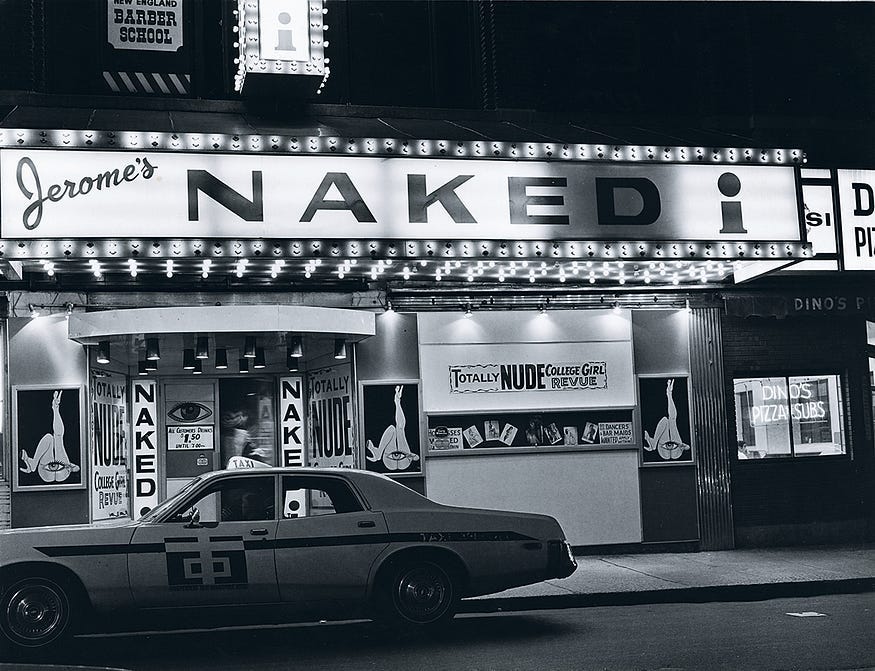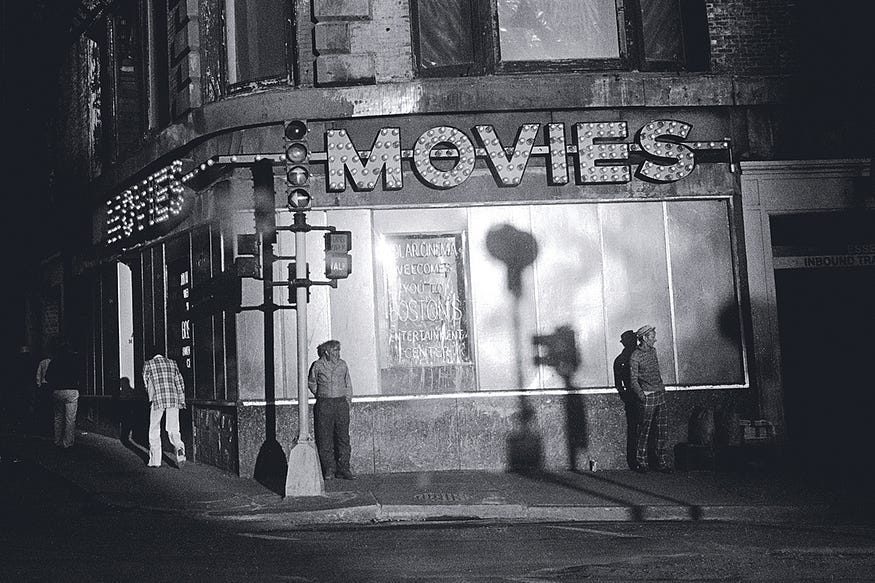A Look at the Rise and Fall of the Notorious Boston Combat Zone
Sex, Sleaze, and “Cold Tea”
Today, Boston Massachusetts is one of the wealthiest and most progressive cities in the United States. Known worldwide for its elite universities and institutions, medical industries, and as a destination for high skilled workers and high-paying job opportunities.
This was not always the case. During the 1960s and 1970s, Boston was suffering from many of the problems that plagued other large cities and urban centers during this time. Problems from urban decay to high levels of crime and violence caused many people who had the means to pick up and leave. Further putting a strain on the city as the tax base began to shrink.
It was during the 1960s that the Boston Redevelopment Authority demolished the city’s former red-light district which had been located at Scollay Square. In turn, many of the strip clubs, porno theaters, peep shows, and street prostitutes relocated to an area adjacent to Chinatown along Washington Street between Boylston and Kneeland Streets.
This area seemed like a logical fit for an adult entertainment and red-light district for several reasons. The first being that they would not be moving far (less than half a mile from Scollay Square) and the rents were cheap compared to other parts of Boston.
Additionally, since part of Washington Street had already been designated by the city as an entertainment and nightlife district, much of the infrastructure was already in place, such as old and unused theaters and burlesque houses that could easily be repurposed for adult entertainment.
Vice City
The origins of the name “Combat Zone” seems to be twofold. The first is due to the area’s reputation for crime. The second was the frequent presence of uniformed servicemen on leave from the Charlestown Navy Yard. These uniformed military personnel frequenting the zone’s establishments gave the area the appearance of an occupied territory.
The biggest victory for the area occurred in 1974. That year, the Massachusetts Supreme Court ruled that the state’s obscenity laws were unconstitutional. Fearing that vice would now become a citywide problem, The Redevelopment Authority and other officials sought to prevent this by seeking to actively contain Boston’s adult entertainment and sex industry within the borders of The Combat Zone.
The Combat Zone was now designated as the official adult entertainment district. This allowed those doing business within the district to largely operate without intrusion or harassment from police or city officials. It is probably not too surprising to learn that many reports of police corruption within the district were made. (And largely ignored)
Many crimes and code violations were not enforced. Including a ban on the sale of beer after hours. It was illegal to sell alcohol after the bars had closed. However, those in the know could go to certain Chinese restaurants after the bars had closed and order some “cold tea” which was just beer served in a teapot. The citywide ban on flashing neon signs was also relaxed within the zone.
The area of LaGrange Street between Washington and Tremont was a central area for prostitutes, a high number of which sadly were minors. The Combat Zone was a hub for other crimes as well. The area had a reputation as a place to buy and sell illegal guns. Drug dealing and gambling were also vices that could be found within the confines of the Combat Zone.
The Beginning of the End
Although the Combat Zone had a seedy reputation, reports of frequent violent crime seem to be exaggerated. However, it would be a high-profile murder in 1976 that would spell the beginning of the end for The Combat Zone. The victim was a football player and senior at Harvard University named Andrew Puopolo.
After a Harvard and Yale football game, Puopolo and some of his teammates had gone out to The Combat Zone to have some fun. As they were leaving a bar and heading for the car, they were approached and solicited by some prostitutes.
When one of the players realized he had been pickpocketed by one of the women, the group pursued them in an attempt to recover the wallet. They soon found themselves in an altercation with a pimp who stabbed Puopolo in the chest. He would later die from his injuries.
This shocking murder came just two weeks after a scathing report by outgoing Police Commissioner Robert DiGrazia about widespread police corruption and brutality within the district. By this time in the mid-1970s, the area had been deteriorating and was neglected and underserved by the city which further added to a sentiment of lawlessness and criminality.
Cleaning Up
Due to these high-profile events, the city began to move in an attempt to clean up and dismantle adult businesses. Whereas before the code violations were overlooked or ignored, they were now being enforced. Establishments were raided, prostitutes were arrested, and liquor licenses were checked and enforced.
Other forces combined to usher in the demise of The Combat Zone. The residents of neighboring Chinatown now had the political influence that they had previously lacked and put pressure on politicians to clean up the vice within The Combat Zone that frequently spilled over into their neighborhood.
Property values within Boston had also risen by the late 1970s and the city was looking to revitalize the area with more upscale real estate. Other factors such as the rise of HIV and the introduction of VHS tapes meant less people going to adult bookstores and theaters.
Today, the area formally known as The Boston Combat Zone is home to several college dorms and administration offices, as well as a Ritz-Carlton Hotel and The Boston Opera House.
Sources
Ramos, Dante. “Murder In The Combat Zone.” Boston Globe, 26 August 2016.
“The Combat Zone: A Look Back At Boston’s Mythical Dens Of Sleaze.” Dangerous Minds, 19 April 2016.
“Wild And Woolly' Combat Zone Just A Part Of Storied Past In Boston's Chinatown.” CBS News Boston, 15 November 2019.





